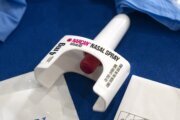When it comes to health and longevity, being poor is expensive. Poverty’s detrimental health effects are many and wide-ranging. From a lack of access to fresh vegetables and lack of money to pay for medications to not having the time off to visit a doctor during business hours, the impacts can be subtle, cumulative and ultimately life-threatening. A 2017 study in the Journal of the American Medical Association found that residents of wealthy counties can have a life expectancy more than 20 years longer than those who live in impoverished counties.
Philip M. Alberti, senior director of Health Equity Research and Policy for the Association of American Medical Colleges, says “there’s an increased awareness and understanding of how poverty — both individual as well as neighborhood poverty — has powerful effects on health and health outcomes. A low-income neighborhood is less able to promote health and wellness,” typically because it offers “lower-quality housing, lower-quality education, decreased access to healthy foods, transportation, child care and safe places to exercise, etc. And a person with limited financial means is less able to access health care to make follow-up appointments or to afford necessary medications. There are so many pathways that connect poverty to health,” he says, and these “partly explain why the U.S. experiences such entrenched disparities and inequities in health. Some groups literally cannot afford to be as healthy as they could be.”
[See: 13 Ways Social Determinants Affect Health.]
Over the past several decades, the health care system as a whole has become more cognizant of the social determinants of health and risk factors that often disproportionately affect the poor and impoverished. In the last several years, medical schools have begun focusing more on poverty to help doctors not only better understand patients they may encounter but hopefully improve their ability to care for them, too.
Poverty and its health impacts is a multi-faceted challenge, and the ways different colleges address this important aspect of training would-be doctors can take a number of forms. All of them help students — who more likely than not come from affluent backgrounds and perhaps have had limited contact with economic hardship prior to arriving at medical school — understand what it’s like to have to choose between paying the rent or buying that needed vial of insulin.
Alberti says one very effective way of introducing students to the challenges of poverty is via simulations. The McGovern Medical School at The University of Texas Medical Science Center at Houston (UTHealth) recently launched a program for medical students using the Community Action Poverty Simulation, which is administered by Rebecca Lunstroth, associate director of the McGovern Center for Humanities & Ethics at UTHealth in Houston.
Lunstroth says the simulation materials were created by the Missouri Community Action Network in Jefferson City and were so extensive, they arrived in a large trunk. The program leads students through a day-long role-playing exercise where they’re assigned to various family units dealing with the day-to-day struggles of poverty. The goal is to be able to pay the rent at the end of the “month,” but all the other financial obligations and crises that crop up along the way derail many of these groups from being able to meet that goal, through no fault of their own. Faculty are also engaged in supporting roles, and Lunstroth says the exercise has been eye-opening for all involved.
Measuring the outcome of such sessions can be challenging, but Lunstroth says post-simulation surveys she’s conducted indicate a “statistically significant increase in sadness [about the causes and effects of poverty] and empathy,” among participants, indicating that they had gained a valuable insight into what it’s like to be poor.
“It was remarkable,” she says. Students commented afterwards on some of the scenarios — one in particular focused on a pregnant woman adamantly demanding to have a C-section scheduled for a Friday, rather than during the week as the doctor wanted. The woman didn’t have the luxury of paid maternity leave and was intending to use the weekend to recover from the surgery before heading back to work on Monday. Lunstroth says powerful examples like that lead to many an “a-ha moment” for students and faculty. “It was definitely a highlight to my tenure here seeing the lightbulb go off for students and faculty,” she says. The first simulation ran last year and was so successful, these poverty simulations are now part of the school’s curriculum going forward.
[See: 11 Ways Rural Life Is Hazardous to Your Health.]
At other universities, facing poverty means leaving campus and venturing into the local community. At the Washington University School of Medicine in St. Louis, confronting poverty and its negative health consequences means a bus trip into the least affluent parts of town to see in person what it’s like to be poor on a daily basis.
“We try to present a perspective to our students that puts patients in context so they’re not just viewing them as patients who are non-adherent or not willing participants in the medical encounter,” says Dr. Will Ross, a nephrologist and associate dean of diversity at the Washington University School of Medicine. “The best thing for us to do is not talk about this in a vacuum or a sterile environment like the hospital, but to truly get [students] to understand where our patients live, how they live, and what are the social factors that impact their ability to live healthfully.”
Rather than just poverty voyeurism, the tour involves thoughtful discussion of what the students observe and how things like vacant lots, buildings in disrepair, a lack of grocery stores and broken street lights can impact health and increase stress on people living in those communities. Students also interact with patients and staff at nonprofit organizations and community health centers in some of the poorer neighborhoods of St. Louis. All of these efforts have “remarkable repercussions by improving the physicians’ ability to relate to the patient to provide more sensitive care and improve patient outcomes,” Ross says.
By increasing this exposure, students become “more empathetic medical practitioners,” who are more likely to earn the trust of patients who may be coming from a background that’s suspicious of doctors or medical authorities. It has also led to the creation of a Saturday health clinic staffed by students, who get both hands-on patient care experience and an up-close encounter with the effects of poverty.
As a result, Ross says “the students, they’re changed. They’re very compassionate, caring individuals coming in, but once exposed to this program — irrespective of whether they want to do primary care or specialty — they are more comfortable interacting with patients from different backgrounds. They have this greater sense of being able to communicate and build trust,” which may improve patients’ compliance with treatment plans. “If we train our physician to really understand why patients do the things they do and to understand that patients are making logical, rational decisions from their perspective, then we won’t be so eager to condemn or judge the patient when they don’t follow through with a medical treatment plan,” he says.
Getting out into the community and having direct contact with people from all walks of life is also part of the program in Columbus, Ohio. Dr. K. Craig Kent, dean of The Ohio State University College of Medicine, says students there are required to commit a minimum of 60 hours of community service over their first two years of school. Time is in limited supply for most medical students, so this obligation is not light, but nonetheless, Kent says many students end up contributing far more than the required amount. “The students get involved in a project and get so excited [about the impact they’re having], they contribute more hours.”
These students are tasked with “creating something new for the community that didn’t exist before,” Kent says, and they’re asked “to be creative and thoughtful” in addressing needs in the community. These projects run the gamut from new approaches to providing community health services to engaging community members in gardening for mental health. Once these students become doctors, not only will they have a greater understanding of how poverty and a person’s environment can impact their health, but they also may incorporate elements of the initiatives they worked on in school into their practice as physicians later on, Kent says.
[See: How Social Workers Help Your Health.]
These efforts can lead to a powerful sense of empowerment for students and the doctors they will become, because “we ask them to become responsible for making changes,” Kent says. “It’s one thing to go out and be involved in service. It’s another to design a program and be the innovators that really change how people behave in the community. It’s that that sense of responsibility that makes them learn how to be more creative and empowered” in addressing the complex factors that can impact health.
Poverty’s effects on health are real and concerning, but as these and other programs around the country are showing, they may not be completely insurmountable. “The group of individuals that is most passionate about thinking around social risk factors, poverty and really helping community health as a way to improve patient health, that group is, without a doubt, students,” Alberti says. Giving them the tools and the exposure to make a real impact is “a natural, logical step,” and will give “the next generation of physicians the means of navigating these communities that aren’t able to promote health to their full extent.”
More from U.S. News
13 Ways Social Determinants Affect Health
11 Ways Rural Life Is Hazardous to Your Health
How Social Workers Help Your Health
How Medical Schools Try to Help Doctors Understand Patients in Poverty originally appeared on usnews.com







